Volume 1 Number 2
©The Author(s) 1999
The School Bus Project
Abstract
A preschool class of 4- and 5-year-old children in a midwestern Christian school chose to study school buses as a class project. This article discusses the goals of the project; describes the three phases of the project, including the children's representation of parts of the bus; provides the teacher's reflections on the project; and presents parents' comments on the project. The article also contains a memory book that documents the project using photographs.
School and Student Background Information
Our preschool is part of a prekindergarten through 12th-grade midwestern Christian school, with roots in the Christian Reformed Church. The church advocates Christian education but does not operate the Christian schools. Our school is owned and directed by members of the Timothy Christian School Society, which is composed of parents of children attending the school and parents of former students. Parents of four children in the class involved in the school bus project were School Society members.
The class working on the project was one of four preschool classes at the school. This class met three mornings a week from 9:30 to 11:30 and was taught by Deb Lanenga and me. We chose this class for the project because Deb could help with videotaping the project activities. The children in the class came from middle- or upper-middle-class families. There were 13 children in the class: three 5-year-old girls, four 4-year-old girls, two 5-year-old boys, and four 4-year-old boys. Nine of the children were in our preschool the previous year, but not all were in the same group. Two of the boys came from homes where two languages were spoken. One girl was diagnosed as a selective mute the previous year, a result of a rare medical condition that had killed her sibling. One boy, whose mother remarried during the summer, showed some changes in attitude and behavior.
Project Background
Thinking about project topics the previous summer, I had been drawn to school buses because our school maintains its own bus fleet and maintenance facility. I knew we would be able to visit the site on foot as frequently as necessary, and the visits would not affect our limit of two field trips a year imposed by the school board for financial reasons. Our bus maintenance supervisor is child friendly, easygoing, willing to help, and open to answering questions, and some of our bus drivers are parents of students or former students who are also respected, helpful, and child friendly.
To see if children would be attracted to or curious about buses, we played several times in the playground area that borders the fence of the bus yard instead of using a closer area. One day in early September, John remarked that there must be about 19 or 100 buses in the bus parking area. Other children made less-spectacular guesses. And so a question was raised, a reason to investigate was provided, and the bus project was launched. (Interest would be further piqued in October when we would travel to the woods in a school bus—excitement about going in a bus usually matched the excitement about our destination.)
Project Goals
We hoped that through working on the school bus project, we could help the children reach a number of different social, academic, physical, and artistic goals. We hoped that the children would have an opportunity to:
- develop skill representing details of what they saw;
- develop their ability to work together toward a goal;
- solve problems together;
- learn how to investigate, ask questions, and gain a greater understanding of their chosen part of the bus; and
- learn to act safely in and around school buses.
Phase 1
Activities
I began Phase 1 by telling stories about my parents taking me on a bus when I was a child because we had no car and later, when I went to school, the teacher taking the class to special places on school buses.
Children were asked to relate any experiences they had had on buses. Amy denied ever taking a bus, although she had been on two field trips with our preschool the previous year. As the conversation continued, she talked about going on Lake Shore Drive in a car or on a little bus, remembering that her mother had difficulty putting the stroller on the bus. Mandy and Nora told about field trip excursions from the previous year. Shawn began talking about going on a bus and seeing dinosaurs. Shawn would talk about dinosaurs at the slightest provocation, and because his English was sometimes unclear, I was not sure if he meant a Chicago or a Pakistani bus. Susan had been on a field trip with us the previous year but did not respond.
After our class meeting, the children were invited to draw, paint, or construct a school bus. Paintings and drawings were simple; most children made several windows and wheels, painting or drawing the body yellow. Donny, whose drawings the previous year were reluctant and scribbled, made an object with multiple shapes and with two straight lines beneath it. Amy commented that Donny didn't have O's for wheels. Stories were dictated and added to the drawings.
The next day, clay was made available for children to sculpt buses. Three children made three-dimensional objects with four wheels. Mandy made a flat-bodied bus with five wheels. She opted not to paint hers. Nora squeezed the clay. Donny chose to try painting a box with yellow and black but did not finish the construction.
At our next meeting, we created a school bus web. Children listed all the things that they could think of associated with buses, including a nonexistent CD player. During the following session, they grouped objects that they felt belonged together, made a list of questions that they wanted answered, and selected what they wanted to investigate. Children tended to choose topics to investigate that they had mentioned in our original webbing exercise.
To conclude this phase, we discussed making an appointment with Mr. Bonnes, the bus maintenance supervisor, to visit the bus barn. Patty volunteered to make the request, so we walked to the bus barn and set a date for the visit.
In preparation for our first site visit, I asked for parent volunteers and sixth-grade student helpers. I also noted each child's questions and choice of bus part to study on his or her clipboard and talked to Mr. Bonnes about the children's questions. He asked if he could take the children for a ride around campus, and so in class I "wondered" if Mr. Bonnes would take us for a ride. The children responded that they would like that, and they wanted to ask him. Jessica volunteered to politely ask Mr. Bonnes.
Reflections on Phase 1
In thinking about the first phase of the project, I realized that there were several things I would have done differently. For example, my stories drew Shawn's attention to going places rather than to his experience with buses. I should have started with the story of my children being picked up by a school bus with lights flashing, rather than telling it later.
Another problem, for me at least, was my discomfort with the videotaping. Although the children seemed to be completely unaffected by the video camera, I was apprehensive, felt that my every word was stilted and unnatural, and felt that every move I made was large and wrong. I found myself offering questions a little too quickly to help Mandy solve her difficulty describing where children sat in the bus. She said the seats were on the outside, but she meant on either side of the aisle on the inside. I leaped in too quickly to help her.
I think I should also have done the webbing in one short session; it dragged on a bit long. I could have asked the children which parts of the bus they wanted to look at during a less formal time or individually. This process might also go faster later in the year, when children would be more comfortable with each other and would understand the routine and expectations of the teachers.
I also discovered that it is not a good idea to display sculptures on the rear of a table where 3-year-olds can stretch to investigate and possibly damage things. Mandy's bus wheels were crumpled.
Phase 2
Field Experience
On Wednesday, two moms and five sixth-graders joined us for our first visit to the bus yard. Each parent or sixth-grade volunteer had one or two children to help. We arrived at the bus barn with clipboards and pencils. Jessica asked if we could have a ride on the bus, and Mr. Bonnes said, "Sure." After he gave some rules for the bus barn and asked the children to find Bus 18, we were off. We were treated to a bumpy ride around the campus with no little heads visible above the seats—just sixth-graders', teachers', and parents' heads.
The children continued their journey to learning by asking questions and by sketching their chosen parts of the bus.
Paul's sixth-grade helper, Luke, who evidenced a sense of humor when he arrived at our room, helped Paul see the lines on the side of the bus, took his pencil now and then to help him finish drawing side lines, added "Timothy Christian School," and graded his paper with an A++. I had explained carefully what to look at and had told Luke that Paul's attention might wander. He did keep Paul focused and interested, and he took his job of helping Paul seriously.
Jorie looked at a side wheel and discovered lug nuts. Her drawing had good detail.
Jessica intently studied the rear of the bus, her helper occasionally helping her focus on details of light placement.
Nora and Amy worked on counting seats, each using her own method—Nora tallied while Amy counted and put down the number 25. Nora drew the driver's seat, Amy a child's bench.
Michael asked Mr. Bonnes about the CD player and discovered there was none. So he and John drew the two-way radio and counted side windows.
Mandy, standing with her mom in front of the bus, cried. She had asked to learn about the front of the bus and its lights, but her drawing shows only an outline and a mirror, which may have had more than a little adult help.
Ashley's work was somewhat puzzling—groups of circles only.
Donny sat in the driver's seat with pure pleasure, pretended to drive, and drew the steering wheel. Ryan, too, smiled with eyes twinkling as he "drove" the bus and drew the windshield. Shawn drew the driver's window—without a dinosaur.
We experienced some frustrating delays getting back for a second visit. Schoolwide preventative lice checks and student pictures consumed two days, and the bus yard was unsafe on a third day because buses were being sold.
For the second site visit, we divided the class in half. Some of the children completed Time II drawings (Note 1), and others sketched a second part of the bus. All the children completed texture rubbings.
To make perspective sketching attainable for Mandy, I asked her if she would like to draw the side of the bus this time, which she did easily. She counted the 12 windows but did not accurately represent them, running out of room, then adding too many on the upper additional row.
Susan, who was absent for the first site visit, drew the stop sign, doing a Time II sketch later from a photograph.
Jorie's Time II sketch shows much growth in attending to detail. Mandy had no difficulty doing a second drawing of the bus side later in the classroom. Each time she experimented with the side drawing, even in another medium, it became better in amount and accuracy of detail. Nora's seat also showed more-confident pencil strokes, and the drawing appeared to have had less adult help with the perspective.
John tried drawing the front of the bus and so did Amy, who chose to draw the front of the bus rather than work on a Time II drawing. Her drawing was very detailed, but she missed the windshield. She noticed license plate numbers and drew in the colors of the lights.
Jessica went by herself behind the bus and sketched, finishing quickly. Her window shapes were not rectangular, but her lights were accurately colored.
We gave Ashley an outline to give her drawing a starting shape. Her lights were less random.
Reflections on Our Field Experience
When I planned our field trip, I had been apprehensive about taking sixth-graders along. Although they acted a bit silly as I described how they were to help, once paired with preschoolers they worked to put their companions at ease, boarded the bus with appropriate good humor, and worked seriously to help their charges meet their goals. This experiment worked very well, and I would not hesitate to pair up helpers with children again. I had been reluctant to ask for their time, but as we proceeded, I found teachers most willing to let older children help. The older children took the work seriously and did it well. High school advanced woods students also came in that week and pitched in eagerly and purposefully. Paul's sixth-grade helper kept him involved with the one-on-one attention even though people were walking around him. I noted that he needed one-on-one help in the class and careful instructions.
In the future, however, I will give more-specific instructions to parent and older children helpers without preschoolers present to help the volunteers understand how much to help preschoolers sketch. Some of the Time I drawings had lines that were too firmly drawn compared to those done on the next unaccompanied visit.
The time-wasting head lice checks, unpredictable class picture taking, and the bus selling interfered with my documenting the project and coordinating with the other teachers. I had wanted to discuss planning, teaching, and schedules with them. I wanted to know whether I was adequately explaining my expectations and objectives for this new process. In the future, I will keep children working in the classroom, let the documentation fall into place later, and keep talking with my colleagues.
Representation
Most children worked on representing what they had drawn using other media such as paint and blocks.
To represent her stop sign, Susan chose paper, pencil, and red construction board. After gathering her materials, she quietly said with head down, "I need help." Questioning by the teacher helped her figure out the shapes, and Mandy offered to help her cut the construction board. They discussed with very few words and a few motions how to proceed. Susan then tackled gluing the pieces together by drizzling puddles along the edge of her smaller piece. Surprisingly, the construction held together.
Ashley chose red paper and red paint to make red lights and yellow paper and yellow paint to make yellow lights. At that time, she had not made the white lights nor checked the number of lights to see if she had enough.
Amy's vision for constructing a bus was to use boxes to sit in. Most of the children understood her to mean using boxes for the seats, and so Nora's mother and uncles made reinforced boxes strong enough for children to sit on. Amy gathered a large box from our collection and drew a grille and top flashing lights on it. Donny joined her in painting, put the top flaps down like the engine hood, and painted them. Amy was upset when she realized that these needed "to be scrunched down so the teacher could sit in there" because she had already drawn the steering wheel inside the box. She had not drawn a windshield in her sketch, and it took a discussion with Donny about motors and hoods and windows for her to understand what was needed. Just as he was suggesting she add a piece of board above her motor, she suddenly motioned him away and said, "I get it. I get it." I was happy she made the change—I could see myself sitting with my chin on my knees in that motor!
Mandy took a 4 ft. x 8 ft. piece of cardboard and drew a 3 ft. bus side complete with many accurate-looking windows and a door. Her mother was amazed: "Wow, Mandy did that all by herself?" Michael and John took another 4 ft. x 8 ft. piece of cardboard and made their side of the bus completely fill the board. Michael wrote "18" on it ("I know that number, I can do it."), and John copied "Timothy Christian School" from a photo (having trouble with the R).
Mandy looked at the two sides, took another 4 ft. x 8 ft. piece, and made a side to match the size of the boys' side. She did it easily, not looking at the boys' side, counted the windows to 11, and then said, "There's one left—uno, teacher, uno—that's one in Spanish."
Donny helped everyone paint, did it carefully, wanted to be in on all work, tried every type of painting implement offered, and evaluated Jessica's painting as messy. When he was asked to explain how it was messy, he said, "She don't have the wheels on," and on a second day, he commented again that her painting was messy. He drew his steering wheel, but seemed to have trouble starting, so I asked what shape the steering wheel was. He said "Round, but I don't know how to make the bumps (the places where the fingers fit). He decided to ignore the bumps and forged ahead. He found a tube in the room to use for the steering column.
Although Jorie carefully studied the wheels as she sketched and her Time II drawing is excellent, her first representation contained many circles. Mr. Bonnes, the maintenance supervisor, brought in a tire rim and separate tire so that Jorie could feel and see the separateness of the parts. We returned to the bus barn to examine a wheel to help her understand that the wheel is permanently on the bus, the rim and tire attached to it with wedges and lug nuts. Her final marker and paint representations are more accurate but not as accurate as her second sketch.
Kindergartners who were passing by commented: "That's a great bus, but it's not ready to play in yet. It needs the windows cut out so you can play." John and Michael said they would like the windows open, so my husband cut them out.
Interest lagged the second week of October. We had a field trip to the woods that took another day. Painting kept a small core of children busy. In small groups at snack time, children listed more questions—questions with "how" and "why" this time, and on October 19, Carol, a bus driver, pulled up in a bus to answer questions. Interest gained momentum on October 21 as our bus looked almost ready to use. Almost everyone painted that day—most children ending up with yellow knees. We returned to Mr. Bonnes to have our newest questions answered. I filled him in on the teacher-sitting-in-the-motor dilemma and other new questions in the morning so that when we arrived, the bus was sitting with its hood up ready to be examined. Mr. Bonnes asked us where the driver sat and asked what would happen if we tried to sit in front of the glass. Some of the children felt more at ease with the hood down, the inner workings being a bit strange. He also showed us the "electric" part of the bus.
Because the children decided on wood and nails to put the bus together, I asked them to measure the sides so we could figure out how long the wood should be. John said we should use a tape measure and that his dad had one. No one could suggest an alternative, nor could the kindergartners passing by give us a useable idea for measuring. One suggested using scotch tape and putting little numbers on it. I told the children how my husband measured in the garden, and so we ended up with a back of the bus that is 7 of Nora's feet and a side that is 11 of Donny's feet.
The industrial arts instructor at the high school developed a plan to put the bus together and sent Matthew, a high school carpentry student, to demonstrate how to pound nails. Armed with goggles, roofing nails, and light hammers, the children gathered. There was much pounding. Paul came right over and worked about 15 minutes. Donny worked the whole hour. Michael and John, who liked to be involved in pretend play together, worked about 20 minutes, both returning at separate times. Everyone but Ashley and Susan participated.
Donny put his steering wheel together with tape and said, "Now we need the things for the feet—the pedals."
On Wednesday, October 28, Nora, Jorie, Donny, Amy, and Paul arrived, took up hammers, and got to work. Unfortunately, the high school carpentry student was not able to come to screw the wood pieces together, but we needed time to measure and plan a place for the benches or seats in the bus. Deb Lanenga and I held the front and a side so the children would figure out how to construct the seats. They agreed on a child's chair for the bus driver. Donny got his steering wheel, but it stretched above the center of the window. The problem was diagnosed immediately—the chair was too low. They thought the solution was to add steel-legged chairs on top of each other until the chairs were three high. This strategy seemed to work until someone arrived with a wooden chair to make the stack even higher. At this point, a teacher intervened saying that this solution was not safe. (The chairs did tip with a little help at the right moment.) I was going to suggest hunting for a bigger chair, when suddenly there were children descending upon the yellow object like ants. Neither of us could reach camera or video camera because our hands were filled with bus sides. Two children moved to the hallway to bring in the motors and fenders. The kindergarten teacher helped Patty place the motor, grabbing the video camera as bus seats were coming through the bus door with smiling children. The bus stop yielded a more-than-full bus, and Ashley asked, "Where are my lights?"
Donny asked for glass for the front window. I told him that glass was too dangerous and asked him if he had any ideas for something like glass. Amy suggested invisible paper. I said that I didn't have any but asked if any of their mothers used something to cover bowls that you could see through? Amy said, "My mom covers her bowls with that foil stuff." Later in the day, she asked if I had any of that foil stuff for the windows. I told her that you couldn't see through foil. She asked, "What stuff do you cover your bowls with?" I responded, "Saran Wrap or foil." She asked if that other stuff was invisible. I assured her you could see through it and in response to her request, I promised to bring some to school. I also thought I heard Donny say he needed keys for the bus.
When all the passengers boarded the bus, Paul wanted to be the driver and of course Donny already occupied that place—so the social learning began.
Donny was still upset with the height of his chair. When the children were asked what else Donny could do to solve the problem, Patty suggested cutting the tube or column supporting his steering wheel to make it lower.
I thought that on Friday we would be able to finish the bus—with screws and stop signs and nonflashing "flashing" lights (if Donny didn't think of more things to add). The children could then play school bus and maybe school too. I thought I would try to have the firemen come soon so we could look at another vehicle.
We did put the bus together on Friday. Our high school student could not come to drill, but the kindergarten teacher helped us instead. The children were quiet, relaxed, and unexcited until the screws went in. Amy and Susan—creators of the front and rear—went to the hall during snack time to glue on Amy's license plates. While Deb and I were videotaping and taking still pictures, the children decided to make a roof for the bus. Extra pieces of cardboard were in the room, and when we returned, the children had put them on the top of the bus. Nora's uncles had sent the cardboard for bus seats, but the children were happy with reinforced boxes to sit on—so now we had a roof. Patty was one of the bodies scurrying to her snack when we returned, and she was the body whose arms reached up through the bus during the first sitting to say, "Now we need a roof."
Reflections on Representation
One child's painting and drawing indicated that she needed help with visual motor coordination. She also seemed to need very specific instructions. She took a long time to respond to questions or statements. I thought that perhaps she had some language-processing problems. I planned on asking for permission to have our learning abilities teacher observe her.
Donny was persistent and observant, asked good questions, was a careful worker, and wanted others to do their work well too. His coordination improved every day. He saw details and solved problems. He had come a long way from the shy, uninvolved child we had in class the previous year.
Jessica preferred to work by herself. She did not like doing things over, and when she decided her work was complete, she considered the task finished. She took pride in what she did. When she worked with her sixth-grade helper Lora, her sketching was excellent, but when she worked by herself, her Time II sketch of bus window rectangles got a lopsided look. Her paintings—with the large movements and messier medium—are also more lopsided. I thought it would be interesting to see how she viewed the door to the bus when it was cut to use.
Susan talked to the video camera and smiled widely as she demonstrated her stop sign. She began to play with noisy, fun-loving Patty, who would look for her regularly.
Patty lost interest in the project until Wednesday, October 21, and Monday, October 26. She painted and pounded and became absorbed in the pounding.
It was rewarding to see the excitement of the children and my colleagues once the bus started taking shape. The kindergarten teacher said she felt like breaking into a chorus of the "Wheels on the Bus"—which the children had completed before she arrived.
The quietness on Friday surprised me, but it made sense—a relaxation after a month of hard work. Donny's whining surprised me, too, but in retrospect made sense also. His sense of purpose was gone for the moment—until the bus was screwed together and he got to play and be the first driver. Paul, who also wanted to be first and in control, said to him, "Here's the keys" (pretend of course).
By Tuesday, four preschool classes had played in the bus. They were respecting it, playing carefully and with joy. One mom from another class volunteered to bring a camera to take her daughter's picture behind the wheel.
Phase 3
Planning a Celebration
On October 21, the children agreed that they would like to have a party to celebrate their bus project with their parents and sing the "Wheels on the Bus."
The children agreed to serve milk and cookies shaped like wheels. Michael suggested putting chocolate chips in the center of the cookies to represent lug nuts. On Monday, October 26, we asked how many cookies we should have, and one child responded 100, another said 10, another 15, then a chorus of 100s erupted. They decided to count how many children we had (13), and Deb Lanenga said she would like a cookie too and so would Mrs. Harkema, which brought the total to 15. Mr. Harkema walked in and said he would like one too, so we were up to 16. We wondered whether that number was going to be enough. The children responded with a resounding "No!" and said that they would need cookies for their moms and dads. Amy said her baby sister didn't have teeth so she wouldn't need one, but Ashley said her baby did have teeth. John said, "I know, we can go home and count our moms and dads." So they had homework (How many people are coming to our party?) and an idea for party invitations.
An informal poll of parents by the teachers showed that Monday, November 2, at 7:00 p.m. would be the best time for our party. John had an idea for the cover of the invitations—"School Bus Party"—and dictated what he thought should be typed on the inside: "Where: Timothy Christian Preschool Room. Come at 7:00 at night."
On October 28, children tallied the number of parents and decided to have chairs for the guests while the children sang and explained what they learned. We planned on decorating our cookies on Monday and reviewing what we learned.
We did make the cookies on Monday (with chocolate frosting to hold on six lug nuts). We also reviewed the "Wheels on the Bus," and Ashley spontaneously sang a needed ending to the line "the guard on the bus goes...in and out."
I was about to tell Donny how I felt about his participation in the project, but I backed off and asked him how he thought he did his work on the bus—how he felt about it. He said, "I did good."
All but one family came to the celebration, including parents and siblings. Several parents I had not met before came, including a father in a wheelchair who had just flown in from out of state.
They asked questions, looked at bus parts that their children pointed out, got in the bus, and studied the picture display. A mom said she thought that the memory book, which contained photographs documenting the project, would be good for children to look at and to learn from. Parents also enjoyed the lug nuts on the cookies.
Reflections on Phase 3
Preparing for the celebration was enjoyable for the children. Amy put down a mark for baby Elizabeth, teeth or no teeth. She had no trouble counting all the tally marks to come up with the 46 cookies needed. Moms asked if they could bring something or help.
I prepared the memory book the week before our bus party with the parents. I started the memory book by scanning the photos, but I did not realize how time-consuming this process was. There was no one to answer my questions on the weekend and so I had text and photos color copied at a local photocopying store. This procedure was expensive, so I made one copy for the party, which we later distributed to parents on an overnight basis.
We were pleased to see so many complete families on a Monday night. All the children's siblings were there. Before looking at the bulletin board and obviously not having heard all the stories of construction from their children, some dads were curious about the ideas for the carpentry. They obviously had not checked the condition of the nails or entry places carefully, because the children deserved full credit for that. The "who framed it" question made sense. Unfortunately, Mr. Senti, the industrial arts teacher, had never been seen by the children. They had decided to use wood to put the bus together but had no idea how to build it, and neither had I. I had hoped we would see him develop the plan, but his free times and their school time did not mesh. He cut our wood and drew lines for placement. Matthew, his student, showed the children how and where to nail. The children did the rest. (Later, I must admit, my husband did some reinforcement with a staple gun.) Children also learned about safety goggles for hammering. Parents were pleased with their children's work, followed their children's interests in the new photographs, and enjoyed the bus itself. Some studied the bulletin board that we had prepared, but more watched the video. For community building, improving parent-teacher relationships, and encouraging interest in their children, the evening was well worth the time and effort spent by all of us.
Parent Comments
After the project was completed, I sent a note home asking parents how they felt about their children's involvement in the bus project. The following notes indicate their positive reactions:
The Bus Project is one that I know my child will remember and take pride in for many years! He got very involved in the project: "My favorite part to make was the steering wheel," he said. It was a team effort, a fun and memorable way to learn to work together! The party was nice—so the kids could share and be proud with us as parents.
I think that the children had a sense of "ownership" with this project. They seemed very serious about it, and I really think they felt they were truly contributing something to the classroom. My daughter would point out buses, large and small, on our way to school, and she still points them out, as if she has a connection to them. Perhaps it's because she has a good understanding of how they work. I thought the bus party was a special way to celebrate their work on the project. It's always fun for the parents to see what their kids are doing in school.
The following note was interesting because the child chose not to participate after she drew a door until we began hammering. It was her idea to add the roof and cut down the steering column. But, unfortunately, those activities were not included in the memory book.
My daughter and I reviewed the school bus memory book and discussed her involvement in the project. She appeared excited about the project and recalled several details about the bus. I was surprised that she did not recall her involvement in creating the details of the bus, such as drawing the windows, doors, or wheels. I believe she was looking for pictures of herself in the book to help her remember what she had done on the project. I do recall her talking about the bus all the time after the project was completed. I think that the children did an awesome job on the project. They appeared to be very interested and very involved in creating this bus....
Another parent commented:
For the classmates, working on the project was an opportunity for the children to learn how important it is to put their ideas, efforts, time, feelings, and thoughts together in order to build their confidence.
Positive effects of the project were noted by another parent:
Looking back on the bus project, I think about how long it was. I see my son's ability to focus on such an in-depth project as a real positive learning. So much today is fast, over, done, and then on to the next thing. The hands-on experience he had will hopefully stick with him as a true appreciation for buses. Lastly, the pure size of the bus they made was awesome!
Another father noted that it was an ambitious project and that he was surprised that the children could capture the details of the bus just by looking at it. I explained that we had spent a lot of time working on that aspect—that we had visited the bus several times, and that each child had drawn his or her part at least once and sometimes three or four times.
Reflections on the School Bus Project
There were a number of things I did not accomplish. Ideally, I would have had the children compare the little buses with the big buses, write stories or narratives of what we had done, and make the words for the memory book. I had hoped to try a Venn diagram with the older children. The children had the data, and I should have done it while some of the children were painting, because later it was just too late—the children had already reached closure.
Through the bus project, I learned a lot about the technology available at school. The scanners and many of the computers, printers, video cameras, and equipment to edit videotape were all new to me. (The computer coordinator teased that I could help the Photoshop high school students with some of their problems.)
I learned that people are willing to help. Before, I always felt that I would be imposing. Sixth-graders, their teacher, the bus mechanic, the industrial arts instructor and his students, parents, the kindergarten teacher (who helped with videotaping and sharing ideas), the fifth-grade teacher, and the middle school teacher (who helped set up and advised on video editing) were all willing to help. A sense of community, support, and unselfish helpfulness are some of the attributes of our staff that I discovered through the bus project.
I also discovered that tape recorders were essential—not only to grab conversation when I was not available but also as a memory aid. I prefer the camera on the spot, but I found the video helpful in preparing this narrative. But to use both required that both teachers be in one place on occasion. I think I prefer to document with a camera—it's less time-consuming and shows the moment almost as quickly with the availability of 1-hour developing. Photos can also be held and used more easily with children.
Next time, I will take much less time for Phase 1 and get to the end of Phase 2 more quickly. The children's first webbing and representations were fine, and the field visits were good, but I need to avoid scheduling conflicts by checking the calendar for possible conflicts. A project scheduled later would not conflict with our adjusting to new children and their adjusting to us. Finishing Phase 2 would not necessarily mean a big production. These children chose to make a big bus (big cardboard had been donated), but we did not know it would be this big.
The play in the bus and sense of community that developed among the children were good: John and Michael; Jorie, Mandy, and Nora; Amy and Donny. Donny was a quiet force, challenging thinking. Amy was involved most of the time, contrary to last year. She is bright, needs to see that others have good ideas, and needs to be challenged. These things happened during the project. The project has been worthwhile for me and has been especially worthwhile for the children.
Our School Bus Project
by
The MWF AM Class
We chose to study school buses because preschoolers look forward to riding on them during field trips; we had easy access to buses, mechanic, and bus drivers; and children see them when we go to the playground.
On one of our playground excursions, a child asked how many buses there were in the bus yard. John ventured a guess of 19 to 100. This gave us a reason to count the big yellow buses, take a closer look, and begin a bus study with the children.
My goals during this long-term project were to give children the opportunity to:
- Develop skill representing details of what they see.
- Develop their ability to work together toward a goal.
- Problem solve together.
- Learn how to investigate, ask questions, and gain a greater understanding of their chosen part of the bus.
- Learn to act safety in and around school buses.
At our first class meeting, several children and the teacher related their personal experiences on school buses and city buses. Children listed anything they knew about buses, then represented their memories in clay, drawing, and stories.
We visited the bus yard several times, doing our own investigations, and consulting with Mr. Bonnes, the bus maintenance supervisor.
As our bus took shape, children encountered difficulties with each others' points of view and how to make their ideas work. They learned to problem solve together and contributed additional suggestions for improving the bus.
Please share this Memory Book with your child. The yellow pages are for adults; the white pages tell our school bus story for the children.
OUR
SCHOOL BUS
PROJECT MEMORY BOOK
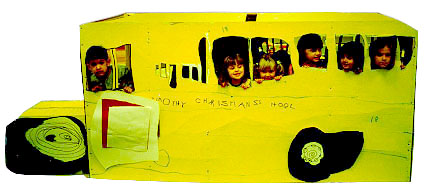

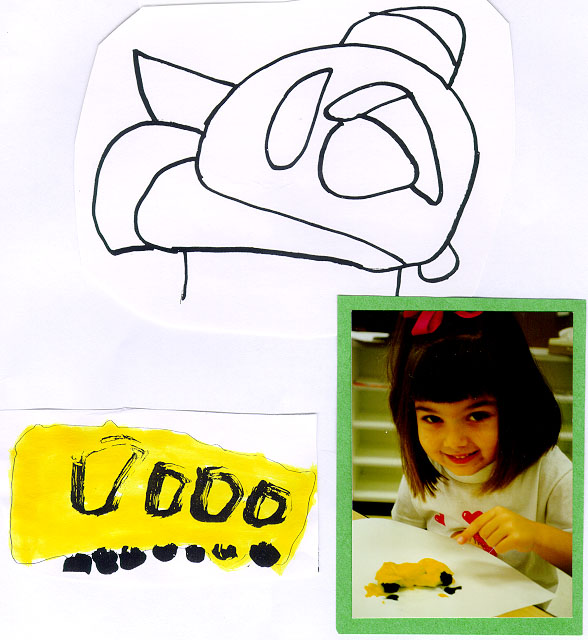
We drew, painted, and made sculptures of buses before we went to look at them.
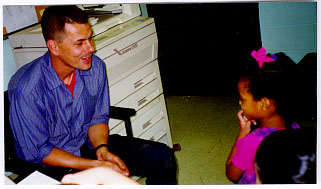
Patty politely asked when we could come to see the buses.
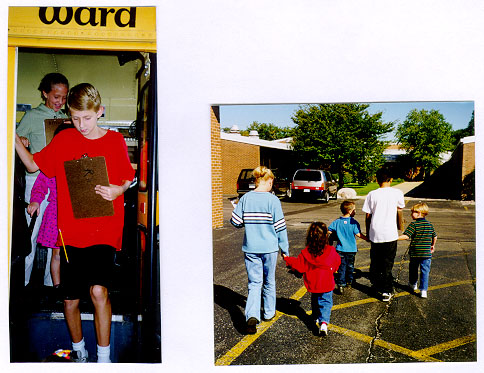
The sixth-graders rode on the bus with us and helped us find what we wanted to draw.
They made sure we were safe in the driveway.
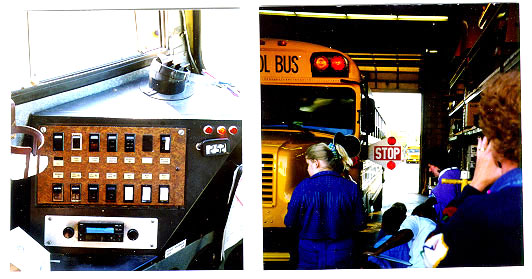
The bus driver pushed one of these buttons to make the lights flash.
When he opened the door, the stop sign came out.

The yellow guard came out to keep children from walking in front of the bus.
Repeated
Sketching
Jorie's
detail in her second wheel amazed me. In a few days' time and with some
discussion with an adult, she was able to capture every detail of the
center of the wheel. She did not transfer all this detail to her final
paint and marker representation, but it is more difficult for children
to reproduce detail in those media.

Jorie looked at the wheels carefully and sketched all the parts.

Jessica drew the emergency door, windows, and the lights. She counted the lights, too. There are 15 lights.
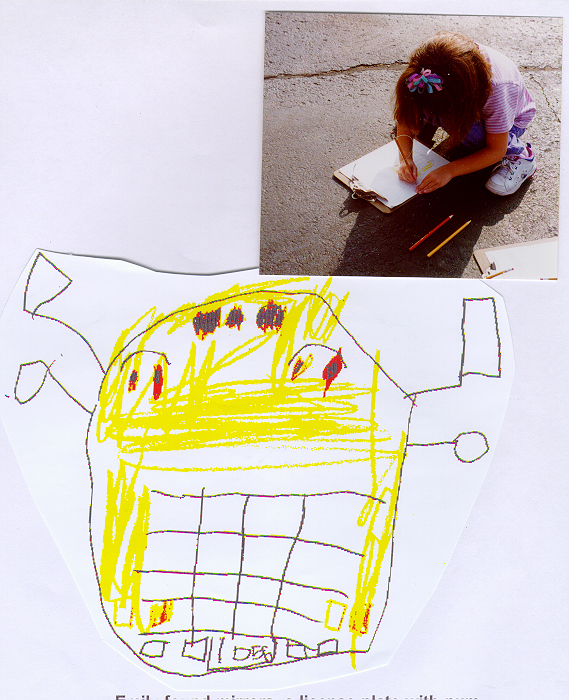
Amy found mirrors, a license plate with numbers, and a lot of lights on the front of the bus.
Counting
Children
need opportunity to count and represent their knowledge of numbers either
by one-to-one matching as Nora did—a mark for each seat—or
by counting and writing down the numeral as Amy did.
Details
Donny
not only noticed the circle shape of the steering wheel but also the
bumps where the fingers fit. When children study a real object closely
using all their senses, and are required to represent that object, their
understanding and learning is real and full of meaning.
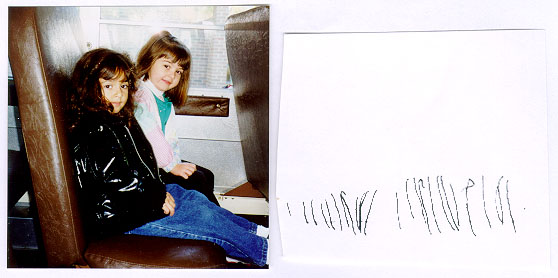
Nora and Amy felt the high backs on the children's seats, and they counted 25 seats. Donny sat in the driver's seat and drew a circle steering wheel.
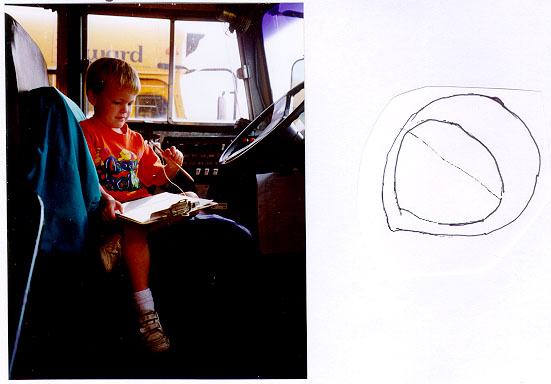


John's Mom helped us look for places with bumps to make rubbings.
More
Questions
After
our first visit and the work of putting the bus together began, the
children developed new questions. These were how and why questions,
questions that indicated children were developing a scientific wondering
and deeper thinking than before. So we made a second visit to the
bus yard and had a bus driver bring a bus to our sidewalk.
We
needed to solve the problem of what's really under the engine hood,
too.
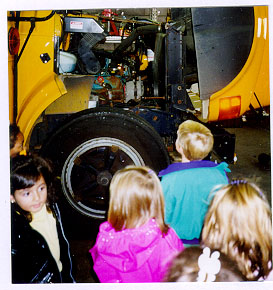
We found out that the motor is under the bus hood,
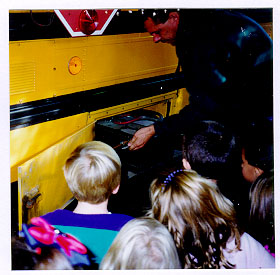
and the electricity comes from the batteries in the side of the bus.

After the field trip, Jessica made the back of the bus.
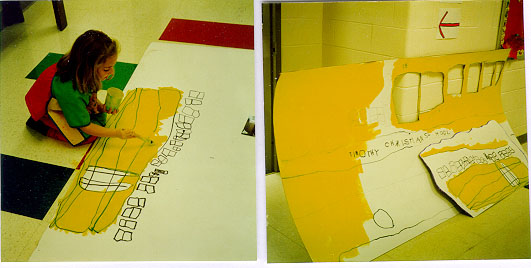
Mandy made a side of the bus, but decided it was too small for Michael's and John's side.

So she made another one with 12 windows and the school name.
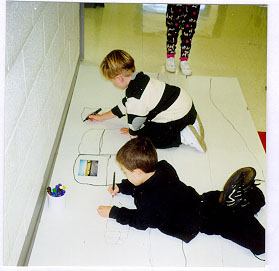
John and Michael designed windows for their bus side.
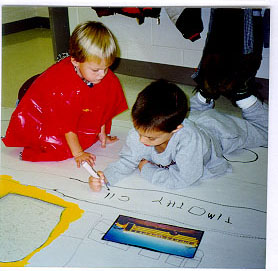
Donny took a break from painting to check John's letters.
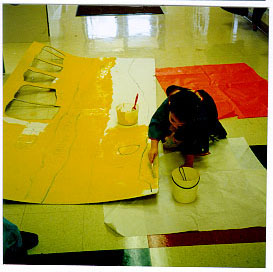
John put on the last coat of paint.
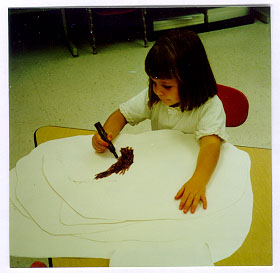
Jorie put some color on her wheels
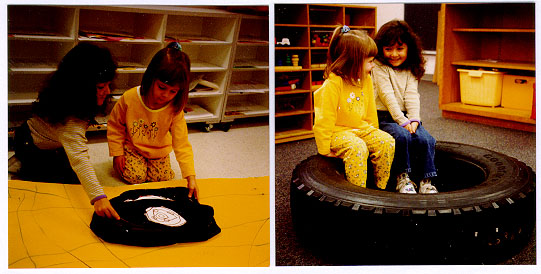
Then Nora helped put them on the bus.
Problem
Solving
Amy's
story demonstrates how difficult it is for children to see someone else's
point of view. It took Amy two days to take another look at the object
she had made in comparison with the work around her, talk the problem
through with Donny, and rethink her position before she could adjust.
Amy's
vision of the bus was a row of boxes for children to sit in, the front
box for the teacher who would drive. Other children were making sides
of various sizes. Donny joined Amy to paint and did the top flaps of
her box, seeing it as an engine hood. She said: "Donny ruined it.
Those are supposed to get scrunched down so the teacher could sit there.
I already made the steering wheel in there." She did not want to
approach Donny with her frustrations. Even after seeing the almost finished
sides and back held together, she did not see that her front of the
bus was not going to fit in. Donny came back and told her, "You
need a board up there for a— Amy, pushing his words back, almost
pushed him back, and said, "I get it. I get it."
I
was very happy to see this problem solved. I did not want to sit with
my knees in my chin!
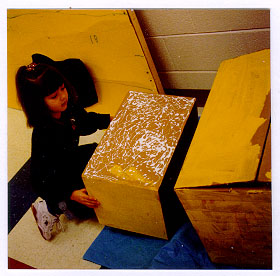
Amy's idea to hold the fenders to the motor worked! She used glue and pushing friends.
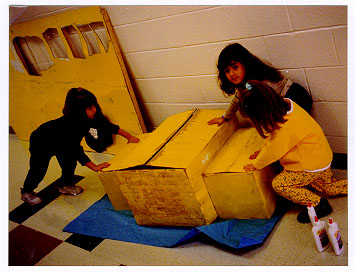
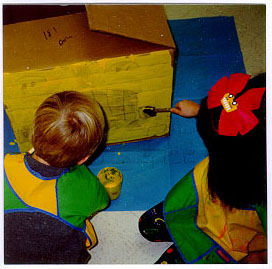
Donny helped Amy paint,
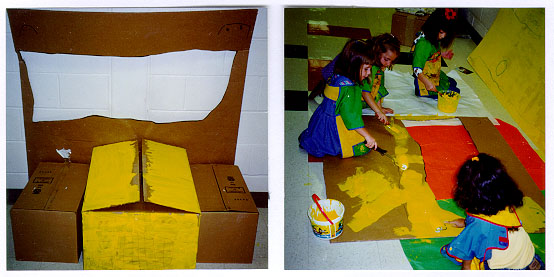
make a windshield and fenders, and more friends came to help with rollers, paint pads, and brushes.
Construction
Design
Mr.
Senti, the high school industrial arts teacher, designed a plan to
put our bus together and sent one of his advanced woods students to
demonstrate pounding nails. Matthew took our work seriously and guided
the children well, helping to get the nails pounded all the way down.
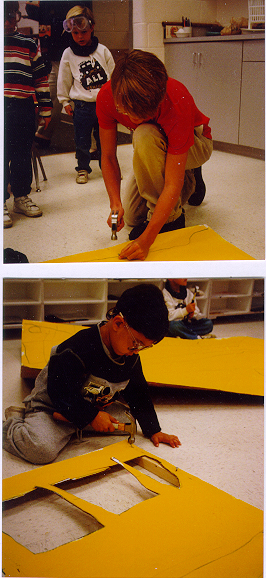
Matthew showed us how to pound nails.
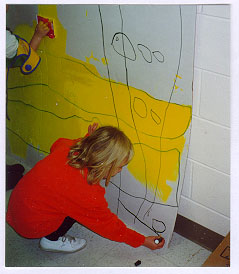
Ashley drew the front door,
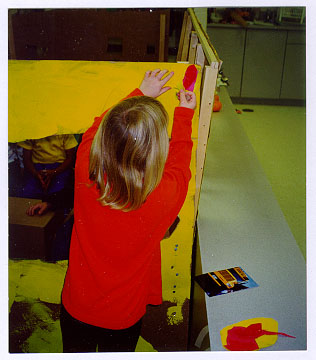
put on the lights,

and we were ready to play!
Celebration
Children
planned to decorate wheel-shaped cookies for our party. Michael suggested
that we use chocolate chips in the middle of the cookies to represent lug
nuts. They asked to sing "The Wheels on the Bus" with verses
about the bus driver, children, lights, stop sign, and yellow guard.
Shawn asked for a verse about dinosaurs, but we decided not to include
that.
The
children understood the elements of a party and had good ideas for food,
invitations, and entertainment.
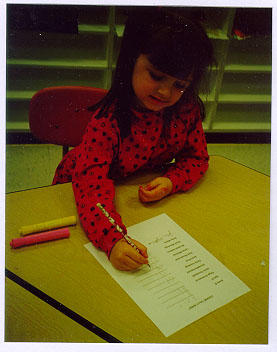
Jessica put down how many cookies we need for her family,
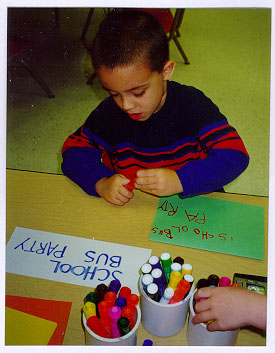
and John wrote his family's invitation.
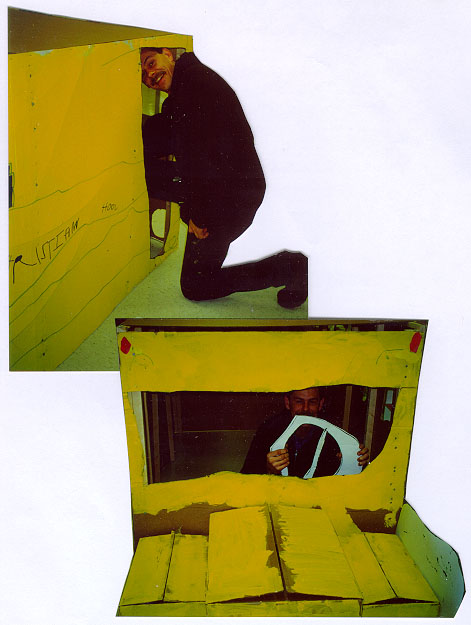
Mr. Bonnes squeezed in and took our bus for a ride.

Donny and Amy took turns driving the bus.
Notes
1. Time I and Time II drawings are terms used to designate drawing the same object in sequence over time.
Author Information
Ruth Harkema is a preschool teacher at Timothy Christian School in Illinois. She has a B.A. in music from Calvin College, Michigan, and a M.A. in early childhood education from Concordia University, River Forest. Illinois. Her interests include the Project Approach, the Reggio Emilia approach, children's artwork, hiking, trees and flowers, and her grandchildren.
Ruth Harkema
Timothy Christian School
188 West Butterfield
Elmhurst, IL 60126
Email: raharkema@yahoo.com

